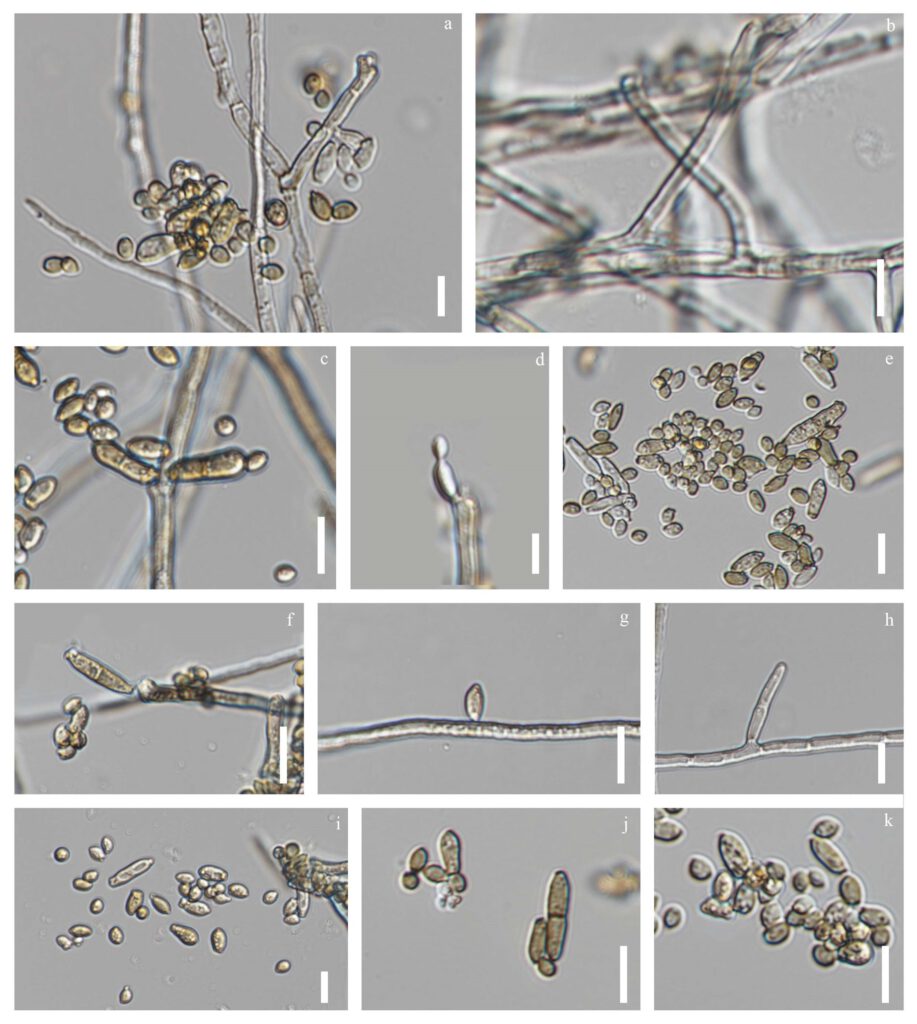Cladosporium tenuissimum Cooke, Grevillea 6(no. 40): 140 (1878) (Intanon4) (Fai)
MycoBank number: MB 145672; Index Fungorum number: IF 145672; Facesoffungi number: FoF 09313;
Saprobic on dead leaves of Rhododendron sp. Sexual morph: Undetermined. Asexual morph: Mycelium superficial and immersed, composed of septate, branched, 2.5–5 μm wide, subhyaline to pale brown, smooth to slightly roughened, thin-walled hyphae. Conidiophores erect, straight, cylindrical, non-nodulose, septate, simple or branched, up to 130 μm long, 2.5–4 μm wide, pale brown, smooth or sparingly verrucose with darkened and refractive scars. Conidiogenous cells terminal or intercalary, cylindrical, geniculate, 7–36 × 2–4 μm, with up to five apical loci of 1.5–2 μm diam, thickened and refractive. Ramoconidia aseptate, subcylindrical to cylindrical, 11–36 × 2–3 μm, pale brown, smooth-walled. Conidia forming branched chains with up to three conidia in the terminal unbranched part, pale brown, sparingly verrucose, with protuberant, somewhat darkened and refractive conidial hila; small terminal conidia aseptate, oval, 5–6.5 × 2–3.5 μm (av. (± SD) 5.9 (± 0.4) × 2.8 (± 0.4)); intercalary conidia aseptate, ellipsoidal to almost cylindrical with attenuated ends, 7–13 × 2.5–3 μm (av. (± SD) 10.6 (± 2.5) × 2.6 (± 0.2)); secondary ramoconidia 0–1-septate, ellipsoidal, 8.5–18 × 2–3 μm (av. (± SD) 14.3 (± 3.3) × 2.6 (± 0.5)).
Material examined – THAILAND, Chiang Mai Province, Doi Intanon, on dead leaves of Rhododendron, 12 October 2019, Napalai Chaiwan, Intanon4, living culture MFLUCC T20–1680.
Host – Human opportunistic pathogen (De Hoog et al. 2011), Fruits of Lagerstroemia sp., Gnaphalium affine, Citrus sinensis, Strelitzia sp., Musa sp., Callistemon viminalis, Magnolia sp. (Sandoval-Denis et al. 2016) and dead leaves of Rhododendron sp. (This study).
Distribution – USA (De Hoog et al. 2011) and Thailand (This study).
GenBank accession numbers – ITS: OM908936.
Notes – In the phylogenetic analysis, our isolate grouped with Cladosporium tenuissimum (Bensch et al. 2010, 2012). A comparison of the phylogenetic tree indicates that our strain is Cladosporium tenuissimum. The distribution recorded of this species collection from various habitats and human, thorancentesis fluid (Sandoval-Denis et al. 2016). This may be due to the difference in the substrate to our new species that isolated from Rhododendron plants host. However our collection are new host record.

Figure *** – Cladosporium tenuissimum (Intanon4, MFLU ***, herbarium). a–b Appearance of fungi on host substrate c–h Conidiophore i–k Conidia and ramoconidia Scale bars: b=10 μm, a=100 μm, c–f, i–k=20 μm, g–h=10 μm.
